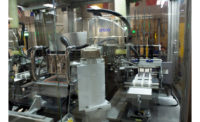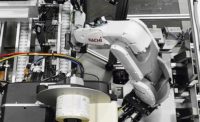Manufacturers love automation, regardless of whether they make super-large items like airplanes, or small commercial products such as disposable razor blade refills. The reason for this affection is simple: Automated equipment makes things more quickly, accurately, consistently and cost-effectively than people.
Ricoh UK Products Ltd. makes midsize products, but relies on automation nonetheless. For example, the company’s Telford, England, facility uses lean and digital manufacturing to produce color toner cartridges for office machines.
In early 2019, Ricoh had integrator Evershed Robotics Ltd. build a new production station there for shutters used on the cartridges. The shutter is what opens and closes the cartridge cap during printing.
Evershed recommended the station be equipped with two TH650A SCARA robots and a Cartesian robot (all from Shibaura Machine) to simplify assembly. The station also features six bowl feeders surrounding a rotary indexer, and an Omron PLC that continuously communicates with the SCARAs.
A high-speed robot, the TH650A SCARA offers an arm length of 650 millimeters (300 on the first axis and 350 on the second) with a maximum payload capacity of 10 kilograms. Its motion range is ±160 degrees on the first axis and ±143 degrees on the second.
System installation took less than 10 days, notes Matt Talbot, a design engineer at Ricoh. Wiring and testing took nearly a week, while further developments to reduce cycle time and improve system efficiency required another couple days.
During production, the first SCARA robot uses sensitive parallel grippers to pick a raw shutter body from a bowl feeder and place it on the indexer. Five parts are then joined to the body in 7.5 seconds to complete the assembly. Next, the second SCARA picks up and rotates the assembly 90 degrees before placing it on a packing tray.
This tray is held in place by a vacuum attachment at the end of the Cartesian robot’s Z-axis arm. After the SCARA robot fills the tray with 72 shutters (eight rows across by nine rows high), the Cartesian robot returns the tray to a shelf within a frame. The Z-axis arm then moves down and selects the next tray for loading.
When all of the trays are loaded, workers enter the station and remove the trays before replacing them with empty ones. The station door is left open during this time to activate light guards, which immediately shut down the Cartesian robot arm.
"This kind of job is made for automation because it’s so intensively repetitive,” says Talbot. “Without automation, the cost of doing it would be very high, and the quality of the assembled parts could not be guaranteed.
“While it was cost that originally prompted us to invest in robots, we have since become keen advocates of their simplicity, reliability and profitability. So much so that we’ve expanded other areas of the [production] line and added three SCARA robots to the heart of separate systems.”
For more information on SCARA and Cartesian robots, call 847-709-7308 or visit www.tmrobotics.com.





